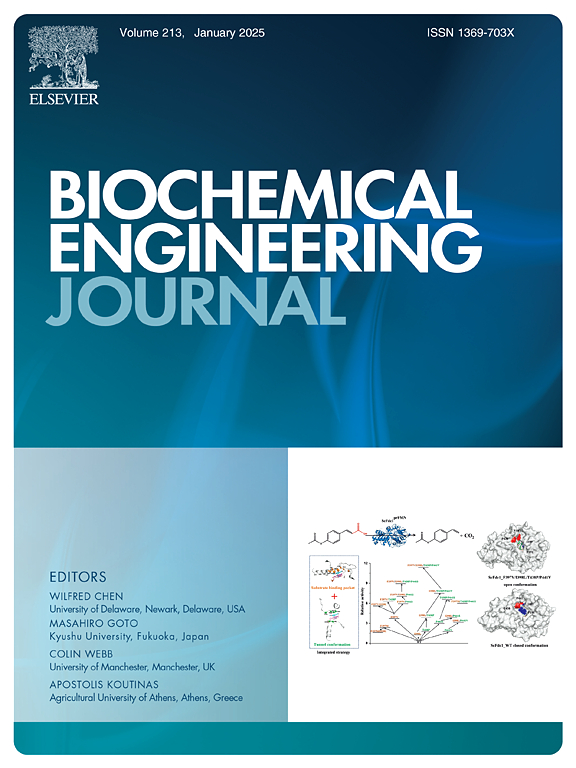Optimization modeling and economics assessment on simultaneous struvite and bioelectricity production from waste nutrient solution in the microbial fuel cell
IF 3.7
3区 生物学
Q2 BIOTECHNOLOGY & APPLIED MICROBIOLOGY
引用次数: 0
Abstract
Several Sustainable Development Goals (SDGs) emphasize community well-being and environmental health. Addressing food and energy demands while ensuring a clean environment remains a global challenge. This study investigates nutrient recovery as struvite and bioelectricity generation from nutrient-rich wastewater using a dual-chamber microbial fuel cell (MFC). Response Surface Methodology with Central Composite Design (CCD) optimized Phosphorus (P) recovery at minimal cost. Simulation parameters, including the N:P ratio, chemical oxygen demand (COD), and cathodic aeration rate, were tested. Results showed that P recovery efficiency was influenced by the N:P ratio and COD, while power density was primarily impacted by COD. Optimized conditions of N:P = 1, COD = 3000 mg/L, aeration = 150 mL/min achieved 90 % P recovery as magnesium ammonium phosphate hexahydrate (struvite, MgNH₄PO₄·6H₂O) with a power density of 860 mW/m². The estimated cost based on CCD simulations was 2.5–2.6 USD/m³ within a 5 % deviation under optimal conditions of N:P = 2, COD = 3000 mg/L, aeration = 150 mL/min. These findings highlight the potential of integrating MFCs into wastewater treatment plants (WTPs) for nutrient recovery, COD reduction, and bioelectricity production. This approach offers a viable solution for sustainable wastewater management but requires careful assessment of Technology Readiness Level (TRL) and System Readiness Level (SRL) for large-scale implementation.
微生物燃料电池废营养液同时产鸟粪石和生物电的优化建模及经济性评价
若干可持续发展目标(sdg)强调社区福祉和环境健康。在确保清洁环境的同时解决粮食和能源需求仍然是一项全球性挑战。本研究研究了利用双室微生物燃料电池(MFC)从富营养化废水中回收营养物为鸟粪石和生物发电。采用中心复合设计(CCD)的响应面法以最小的成本优化了磷的回收率。模拟参数包括N:P比、化学需氧量(COD)和阴极曝气速率。结果表明:磷回收率受N:P比和COD的影响,而功率密度主要受COD的影响。优化条件为N:P = 1,COD = 3000 mg/L,曝气= 150 mL/min,六水磷酸铵镁(鸟粪石,MgNH₄PO₄·6H₂O)的P回收率为90 %,功率密度为860 mW/m²。在N:P = 2、COD = 3000 mg/L、曝气= 150 mL/min的最优条件下,CCD模拟估算成本为2.5 ~ 2.6 USD/m³ ,误差在5 %以内。这些发现突出了将mfc整合到废水处理厂(WTPs)中用于营养物回收、COD降低和生物电生产的潜力。这种方法为可持续废水管理提供了可行的解决方案,但需要仔细评估大规模实施的技术准备水平(TRL)和系统准备水平(SRL)。
本文章由计算机程序翻译,如有差异,请以英文原文为准。
求助全文
约1分钟内获得全文
求助全文
来源期刊

Biochemical Engineering Journal
工程技术-工程:化工
CiteScore
7.10
自引率
5.10%
发文量
380
审稿时长
34 days
期刊介绍:
The Biochemical Engineering Journal aims to promote progress in the crucial chemical engineering aspects of the development of biological processes associated with everything from raw materials preparation to product recovery relevant to industries as diverse as medical/healthcare, industrial biotechnology, and environmental biotechnology.
The Journal welcomes full length original research papers, short communications, and review papers* in the following research fields:
Biocatalysis (enzyme or microbial) and biotransformations, including immobilized biocatalyst preparation and kinetics
Biosensors and Biodevices including biofabrication and novel fuel cell development
Bioseparations including scale-up and protein refolding/renaturation
Environmental Bioengineering including bioconversion, bioremediation, and microbial fuel cells
Bioreactor Systems including characterization, optimization and scale-up
Bioresources and Biorefinery Engineering including biomass conversion, biofuels, bioenergy, and optimization
Industrial Biotechnology including specialty chemicals, platform chemicals and neutraceuticals
Biomaterials and Tissue Engineering including bioartificial organs, cell encapsulation, and controlled release
Cell Culture Engineering (plant, animal or insect cells) including viral vectors, monoclonal antibodies, recombinant proteins, vaccines, and secondary metabolites
Cell Therapies and Stem Cells including pluripotent, mesenchymal and hematopoietic stem cells; immunotherapies; tissue-specific differentiation; and cryopreservation
Metabolic Engineering, Systems and Synthetic Biology including OMICS, bioinformatics, in silico biology, and metabolic flux analysis
Protein Engineering including enzyme engineering and directed evolution.
 求助内容:
求助内容: 应助结果提醒方式:
应助结果提醒方式:


